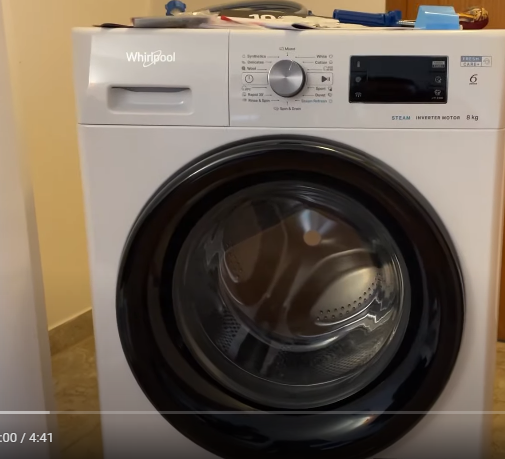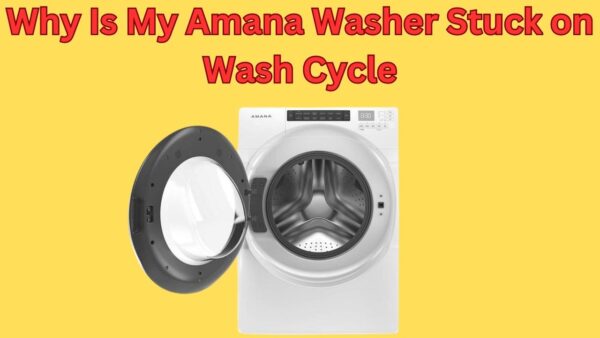Experiencing issues with your Whirlpool washer not agitating properly? You’re not alone.
This is a common problem that many Whirlpool washer owners face.
Whether it’s a slight disruption or a complete failure to agitate, this can significantly affect the performance of your washer, leaving you with poorly cleaned clothes.
This guide compiles 15 potential fixes to help you troubleshoot and resolve this problem, getting your washer back to its optimal operation.
Why is my Whirlpool washer barely agitating?
A Whirlpool washer might barely agitate due to worn agitator components, like agitator dogs, that no longer grip effectively.
Another common issue is a stretched or damaged drive belt, which can reduce the power needed to move the agitator.
A faulty lid switch could also disrupt the cycle, as it might not fully engage the machine’s functions.
Over time, a weakened motor coupler can cause the agitator to lose efficiency, especially with heavy or frequent loads. Electrical problems, such as control board malfunctions or wiring issues, can also lead to poor agitation that needs immediate troubleshooting.
How do I know if my Whirlpool agitator is bad?
A Whirlpool agitator may be bad if your clothes aren’t coming out clean after a wash.
Check for unusual noises, like rattling or grinding, during the wash cycle. If the agitator isn’t moving or is spinning inconsistently, it’s another clear sign there’s a problem.
Worn-out agitator dogs or broken components may cause these issues and disrupt performance. Inspecting the agitator for visible damage or testing its motion can help confirm if it needs repair or replacement.
Why is my washing machine barely agitating?
A washing machine barely agitating often points to a mechanical or electrical problem. Commonly, issues like a washing machine not agitating are caused by worn-out agitator components or a damaged drive belt. For example, if the agitator is not working on your Whirlpool washer, it might be due to broken agitator dogs.
Sometimes, a Whirlpool washer won’t agitate but will spin—this could indicate a faulty motor coupler or lid switch. More advanced problems, like a malfunctioning Whirlpool washer control board flashing green light, may require professional repair. Overloading can also strain parts, leading to a Whirlpool washing machine agitator not working as expected.
Regular maintenance and prompt repair can extend the life of your washer and keep it running smoothly.
What Are The Most Common Causes of a Whirlpool Washer Not Agitating?

1. Damaged Drive Belt
A common cause for a Whirlpool Washer not agitating properly can be a damaged drive belt.
The drive belt is a critical component that connects the motor to the agitator, enabling the necessary movements for a thorough wash.
Over time, the belt can wear out or break due to frequent usage, leading to an ineffective agitator.
Fix:
As a solution, the drive belt should be inspected for any signs of damage such as fraying or excessive slack.
If any damage is detected, the belt needs to be replaced. It’s advisable to contact a professional technician for this task to ensure proper installation and avoid further complications.
2. Broken Agitator
A broken agitator in your Whirlpool washing machine can be the root cause of improper or no agitation.
The agitator, which is part of the washer that creates the thrusting motion, can be impaired due to wear and tear, leading to a malfunctioning machine.
If your washer isn’t agitating properly, inspect the agitator for any visible damage.
Fix:
The solution may vary from minor fixes like tightening a loose agitator to replacing it if it’s beyond repair.
Always consider consulting a professional if you’re unsure about the process to prevent further damage.
3. Faulty Lid Switch Assembly
The Lid Switch Assembly is a critical component in your Whirlpool washer that signals the machine to start agitating when the lid is securely closed.
If this assembly is faulty, it may prevent your washer from agitating properly, or at all.
Common signs of a defective lid switch include the washer not agitating or spinning despite the lid being closed, or the machine not filling with water.
Fix:
The solution typically involves replacing the faulty lid switch assembly.
Although it’s possible to do this yourself with the correct tools and safety precautions, calling in a professional is recommended to ensure a safe and effective repair.
4. Malfunctioning Motor Coupler
A common issue that may lead to your Whirlpool washer not agitating properly is a malfunctioning motor coupler.
This component links the motor to the transmission and often wears out due to heavy use or overloading.
Symptoms of a failing motor coupler include a clicking sound during the wash cycle or the machine failing to agitate but still spinning.
Fix:
To fix this, you’ll need to inspect the coupler and replace it if it’s broken or worn out.
Notably, it’s best to seek assistance from a professional technician if you’re unfamiliar with home appliance repairs.
5. Impaired Transmission
An impaired transmission in your Whirlpool washer can result in inefficient or non-existent agitations.
The transmission unit is responsible for controlling the agitating and spinning actions.
If it’s damaged or worn out, these functions could be compromised.
This is often a result of extensive usage or improper operation.
Fix:
The solution to this issue is typically a professional repair or replacement of the transmission.
It’s worth noting that this can be a complex and potentially costly undertaking, hence the decision should be made after careful assessment of the washer’s overall condition and age.
6. Broken Agitator Dogs
Agitator dogs, small components within the agitator assembly, play a pivotal role in the agitation cycle of your Whirlpool washing machine.
These components are designed to catch and rotate the upper agitator, generating the necessary motion to effectively clean your clothes.
Over time, due to regular wear and tear, agitator dogs can break or wear out, leading to inefficient or non-existent agitation.
Fix:
In such cases, the solution typically involves replacing the worn-out agitator dogs.
It’s a straightforward process that requires removing the agitator and replacing the old dogs with new ones.
Remember: always disconnect the washing machine from the power source before attempting any repairs.
7. Damaged Motor
A faulty or damaged motor could be the culprit if your Whirlpool washer isn’t agitating properly.
The motor, pivotal to the washer’s operation, drives the agitator.
If it’s compromised, you’ll likely notice a lack of motion or inconsistent movement in the agitator.
Fix
To confirm this, check for any unusual sounds or smells emanating from the motor area.
Replacement is typically the most effective solution for a damaged motor, and while it’s possible to undertake this task yourself, it’s generally recommended to seek professional assistance to ensure accurate diagnosis and repair.
8. Worn Out Drive Block
The Drive Block connects the washer’s inner tub to the transmission.
If it’s worn out, the tub may not spin properly, leading to an ineffective wash cycle.
A common symptom of a worn-out Drive Block is the machine’s inability to agitate – the tub can spin but not move back and forth.
Fix:
To rectify this, you need to replace the faulty Drive Block. Remember to disconnect the washing machine from its power source before starting any repair.
Consult your washer’s manual for specific instructions, and if necessary, consider professional help to ensure a proper fix.
9. Defective Timer
A defective timer can lead to your Whirlpool washer not agitating properly, disrupting the machine’s washing cycle.
The timer controls the sequence of washing operations – like filling, washing, and draining – and directs electrical flow to these components.
If the timer is faulty, it might not send sufficient current to the agitator, resulting in inadequate or no agitation.
Fix:
To solve this issue, test the timer with a multimeter. If the multimeter indicates a malfunction, replace the timer.
Always remember to disconnect the washer from the power source before starting any repair work.
10. Inadequate Water Level
An inadequate water level in your Whirlpool washer can hinder the appliance’s ability to agitate properly.
This issue often arises when the water level switch, responsible for ensuring the tub has the correct amount of water, malfunctions.
If the tub isn’t filled enough, the clothes won’t interact effectively with the agitator, resulting in incomplete or subpar cleaning.
Fix:
To resolve this problem, check your washer’s water level switch for potential damage.
If it’s defective, replacing the switch should restore your washer’s normal function.
Keep in mind that any replacement or repair should be undertaken following safety procedures or by a professional technician.
11. Worn-Out Splines
The splines are the ridges on the agitator’s shaft that fit into grooves within the agitator itself, allowing the two to move together.
Over time, these splines can wear out, causing the agitator to struggle or stop moving completely.
This is a common cause for a Whirlpool washer not agitating properly.
Fix:
The solution to worn-out splines typically involves replacing the faulty agitator.
It’s a relatively straightforward repair that involves removing the old agitator and installing a new one.
However, if you’re not comfortable doing this yourself, it’s advisable to hire a professional appliance repair technician.
12. Faulty Drive Pulley
The drive pulley can be a possible culprit when your Whirlpool washer is not agitating properly.
This component transfers the washer’s movement from the motor to the drum.
If it becomes worn out or damaged, it may not be able to perform its function, resulting in the washer failing to agitate.
Fix:
To solve this issue, inspect the drive pulley for signs of wear or damage.
If you find any, then a replacement may be in order.
Replacing the drive pulley involves detaching it from the washer and installing a new one in its place – a task that should be done by a professional to ensure correct installation.
13. Clogged Fabric Softener Dispenser
A clogged fabric softener dispenser can be a common culprit when your Whirlpool washer is not agitating properly.
Over time, residue from fabric softener or detergent can build up in the dispenser, inhibiting the smooth flow of these liquids during the wash cycle and affecting the machine’s performance.
Fix:
To rectify this issue, remove the dispenser and clean it thoroughly using warm water and mild detergent.
Ensure that all residue is removed and the dispenser is dried properly before reattaching it to your washer.
Regular cleaning can prevent future clogs and ensure the optimal performance of your washing machine.
14. Ineffective Pressure Switch
An ineffective pressure switch can impede the agitating process of your Whirlpool washer.
This component is responsible for detecting the water level in the washer’s drum.
If it’s malfunctioning, it may misread the water level, causing the machine to not agitate correctly or even at all.
Fix:
To remedy this issue, you need to inspect the pressure switch, which is typically located behind the control panel.
If it’s visibly damaged or unresponsive to testing, replacement is necessary.
Always remember to unplug the machine before attempting any repairs, or consider hiring a professional if you’re uncomfortable performing the task yourself.
15. Faulty Control Board
The control board is the brain of your washing machine, directing all its operations, including agitation.
When the control board malfunctions, it may send incorrect or no signals to the agitator, resulting in improper or no agitation.
Fix:
Symptoms of a faulty control board may include erratic behavior, the washer stopping mid-cycle, or failure to start at all.
If you suspect the control board, it’s best to consult a professional, as dealing with electrical components can be risky.
A technician can confirm the issue and replace the control board if necessary, restoring the washer’s normal function.
Conclusion
Whirlpool washer not agitating properly can be frustrating and disrupt your daily routine.
However, it’s often caused by common issues such as worn-out agitator dogs, a faulty transmission, or a malfunctioning motor coupler.
With a bit of troubleshooting, these issues can be identified and potentially resolved without requiring professional assistance.
Always remember to disconnect the washer from the power source before attempting any repairs to avoid electrical shock.
If the problem persists after your troubleshooting efforts, it may be time to consult with a professional appliance repair service.


